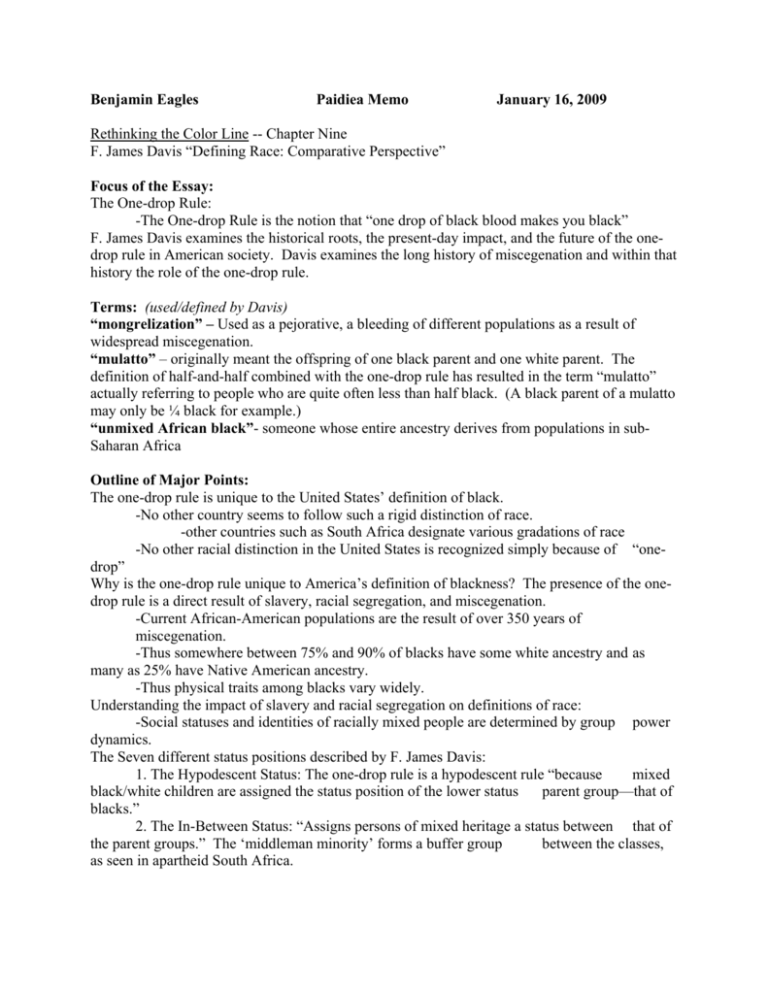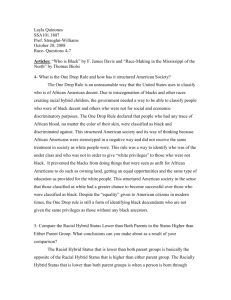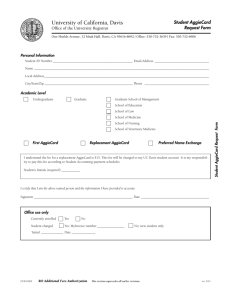
Benjamin Eagles
Paidiea Memo
January 16, 2009
Rethinking the Color Line -- Chapter Nine
F. James Davis “Defining Race: Comparative Perspective”
Focus of the Essay:
The One-drop Rule:
-The One-drop Rule is the notion that “one drop of black blood makes you black”
F. James Davis examines the historical roots, the present-day impact, and the future of the onedrop rule in American society. Davis examines the long history of miscegenation and within that
history the role of the one-drop rule.
Terms: (used/defined by Davis)
“mongrelization” – Used as a pejorative, a bleeding of different populations as a result of
widespread miscegenation.
“mulatto” – originally meant the offspring of one black parent and one white parent. The
definition of half-and-half combined with the one-drop rule has resulted in the term “mulatto”
actually referring to people who are quite often less than half black. (A black parent of a mulatto
may only be ¼ black for example.)
“unmixed African black”- someone whose entire ancestry derives from populations in subSaharan Africa
Outline of Major Points:
The one-drop rule is unique to the United States’ definition of black.
-No other country seems to follow such a rigid distinction of race.
-other countries such as South Africa designate various gradations of race
-No other racial distinction in the United States is recognized simply because of “onedrop”
Why is the one-drop rule unique to America’s definition of blackness? The presence of the onedrop rule is a direct result of slavery, racial segregation, and miscegenation.
-Current African-American populations are the result of over 350 years of
miscegenation.
-Thus somewhere between 75% and 90% of blacks have some white ancestry and as
many as 25% have Native American ancestry.
-Thus physical traits among blacks vary widely.
Understanding the impact of slavery and racial segregation on definitions of race:
-Social statuses and identities of racially mixed people are determined by group power
dynamics.
The Seven different status positions described by F. James Davis:
1. The Hypodescent Status: The one-drop rule is a hypodescent rule “because
mixed
black/white children are assigned the status position of the lower status
parent group—that of
blacks.”
2. The In-Between Status: “Assigns persons of mixed heritage a status between that of
the parent groups.” The ‘middleman minority’ forms a buffer group
between the classes,
as seen in apartheid South Africa.
3. Bottom of the Ladder: By this rule, “persons of mixed race are assigned a status
lower than that of either parent group.” A clear example of this phenomenon is the
discrimination against Korean American and Vietnamese American children
in Korea and
Vietnam.
4. Top of the Ladder: This phenomenon involves mixed race people attaining a higher
social status than either parent group. This seems to be a rare status
position but was seen
in Mexico.
5. Highly Variable Status: Found in Latin America. Mixed race people can use
education and money to “climb the class ladder.” “The expression ‘moneywhitens’ indicates that class can have more weight than physical traits in determining
racial classification” (Davis p. 66).
6. Egalitarian Pluralism for the Racially Mixed: This phenomenon can be found in
Hawai’i, where racial traits play practically no role in class placement. In Hawai’i, status
of mixed-race people depends solely on their education and
economic success.
7. Assimilating Minority Status: This status is reserved for those in the US
descended from minorities other than African American. Gradually certain races have
been able to assimilate as Americans, rather than some ‘other.’
The Multiracial Identity Movement:
This movement has challenged the one-drop rule, but has been met with challenges by blacks
and whites. The “check only one” instruction on the census was a result of the one-drop rule.
Many in the black community have stood against defining part-black people as multiracial for
fear that they would lose constituents and power. Interracial marriage stands to threaten distinct
notions of race regardless of any concretely understood multiracial identity. It is unclear what
the future of the one-drop holds and which of the six other models of racial status positions
African-Americans might follow.
Quotes:
“The one-drop rule was crucial to maintaining Jim Crow segregation, in which widespread
miscegenation, not racial ‘purity,’ prevailed. The racial double standard of sexual relations
gave white men access to black women but protected white women from black men. The entire
system of white domination would be threatened by a mixed child living in a white home” (Davis
63).
“Most blacks want equal treatment and economic and political integration, not total
assimilation. Some barriers to opportunities have been lowered, but there is still considerable
opposition by both whites and blacks to more informal contacts” (Davis 70).
Questions for discussion:
Black/white sexual relations were typically between black women and white men, but
black/white marriages, which are on a rise, occur predominantly between black men and white
women. Why might this be the case?
Why do we bother forcing people to declare their race in the census? Could it possibly be to
perpetuate notions of race?
Given that the differences between the 7 racial statuses are largely determined by history
(colonialism in Latin American, slavery in US, etc) how could the US change to one of the other
models of race as Davis postulated? That is, we can’t change history, so what are possibilities
for changing the way we look at race to that of Hawai’i?









